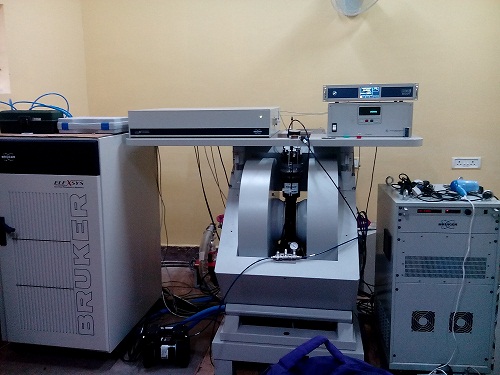- APPLY FOR SLOT
- Internal Users
- External Users
- SLOT BOOKING STATUS
Pulsed Electron Spin Paramagnetic Resonance Laboratory

Phone : +91-3222-283804
Location : OB / GF / *, CRF
Facilitator :
Dr. Debamalya Banerjee, Physics
Email: debamalya@phy.iitkgp.ac.in, Contact:+91-3222-283804
For Internal Users - Click Here to apply for Slot
For External Users - Click Here to apply for Slot
Objectives
Detection of unpaired electron spins and their interaction with neighbouring lattice. This instrument is capable of detecting electron spin concentration as low as 1017/cc.
People

Dr. Debamalya Banerjee
Facilitator
Physics
debamalya@phy.iitkgp.ac.in
+91-3222-283804

Mr. Arijit Maity
Technical Staff
Central Research Facility
arijitmaity97@gmail.com
Equipment Details
Pulsed Electron paramagnetic resonance (EPR) Spectrometer (X-band)
Manufacturer: Bruker.
Model No.: ELEXSYS 580
Year of installation: 2016
Specifications:
| Microwave frequency range | X-band (8-12 GHz) |
| Magnetic field scan range | -1 to 1 Tesla |
| Temperature range | 4.2 to 160 K and room temperature |
| Maximum microwave power | 150 mW |
| Modulation field amplitude | 10 G max |
| Modulation field frequency | 10-100KHz |
| Quadrature detection | Real and imaginary |
| Sample state | See details afterwards |
Utility and Working Principal
Any unpaired spin has a net magnetic moment. EPR spectroscopy exploits the net magnetic moments of systems having unpaired electron spins. Spin hamiltonian of an unpaired electron in an external magnetic can be written as:
H = ge ????B B0 .?
= ge ????B B0 Sz (B0 ? ? direction)
= ge ????B B0 Ms (MS=±1/2)……………………………..(1)
Here ge (=2.20023) is g-factor of free electron, ????B (=9.27?10-24 J/T) is Bohr’s magneton,
Ms is spin projection quantum number. If the electron is bound e.g. an electron captured in
a dangling bond state, then ge would be replaced by g.
The energy difference between two Zeeman energy levels is, ????E= g ????B B0. Now, if a microwave of frequency ???? is applied, then a resonant absorption of microwave will occur if energy of microwave photon becomes equal to energy difference between the two Zeeman levels i.e.,
h????= g ????B B0 ; with selection rule ???? MS=±1 for ESR transition.
At thermal equilibrium the fractional population of upper and lower spin level can calculated by Boltzmann’s distribution law as,
Nlow-NupNlow+Nup=ΔNN=1-exp?(-ΔEKT)1+exp?(-ΔEKT)……………………….(2)
Where N is total number of spins in the system, Nlow and Nup are spin population in upper and lower spin energy level, K is Boltzmann’s constant, and T is temperature.
Now microwave absorption intensity (IESR) is proportional to the population difference between two energy levels [5] i.e.
IESR∝ΔN=Nlow-Nup≈N.gμBB02KT, whenΔEKT?1……………(3)
Since IESR is proportional to resonant magnetic field B0 (and hence resonant frequency) and inversely proportional to temperature, the signal to noise ratio can be improved by measuring ESR at low temperature and at high microwave frequency. Equations (2) and (3) is only valid for isolated spins such as dangling bond states which are not coupled.
is proportional to resonant magnetic field B0 (and hence resonant frequency) and inversely proportional to temperature, the signal to noise ratio can be improved by measuring ESR at low temperature and at high microwave frequency. Equations (2) and (3) is only valid for isolated spins such as dangling bond states which are not coupled.
Sample Details
A. For Solid Sample:
i) Sample has to be filled in glass capillary tube with both side sealed.
OR
ii) Sample has to be filled in standard quartz (NMR/EPR) tube (250 mm
long and diameter < 4 mm).
B. For Liquid Sample:
i) Non-aqueous (Non H-bonded): Sample has to be filled in standard EPR
quartz tube / glass capillary with both side sealed (if both side sealing is not
possible, then other side has to be sealed well with paraffin wax).
ii) Aqueous/H-bonded: Sample has to be filled in thin glass capillary with
both side sealed (if both side sealing is not possible, then other side has to
be properly sealed with paraffin wax). Total sample volume must be less than
10 microlitter.
Reason: Aqueous/H-bonded samples absorb lot of microwaves. We cannot
tune the microwave bridge with excess sample volume due to this absorption.
****** If above guideline is not followed, then we might not be able to
accept samples.
